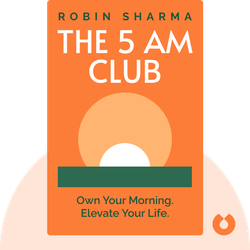Try Blinkist to get the key ideas from 7,000+ bestselling nonfiction titles and podcasts. Listen or read in just 15 minutes.
Start your free trial
Blink 3 of 8 - The 5 AM Club
by Robin Sharma

Additional Serious Scientific Answers to Absurd Hypothetical Questions
What If? 2 by Randall Munroe is a book that answers bizarre hypothetical questions with science, wit and creativity. It offers fascinating insights into the forces that shape our world and expands our knowledge in a fun and engaging way.
Do you want the bad news first, or the good news?
Well, let’s go with the good news: Jupiter is roughly the same density as water. If Jupiter was house-sized – so, let’s say about 50 feet wide – it would only weigh 2,500 tons. Meaning, your new neighbor isn’t about to mess around with your gravity by forming a black hole.
The bad news is that Jupiter isn’t actually made of water. Before Jupiter was, well, Jupiter, it was a big diffuse cloud of gas floating through space. Then, gravity caused this gas cloud to collapse in on itself. When gas is compressed it gets hot. Seriously hot. Jupiter, much like Earth, is formed of a thin, cool surface layer that keeps a lid on a scorching hot interior. As in, tens of thousands of degrees hot. Like all things that are blazing hot and super-compressed, Jupiter’s interior wants to expand. It doesn’t, but only because its own super-strong gravitational forces counteract that impulse.
Shrink Jupiter down to the size of a house and that massive gravitational force disappears.
So here’s what would happen.
Jupiter would expand rapidly outward in a boiling-hot fireball. That’s going to have quite a negative impact on property values in your street; because your street is going to be obliterated. In fact, your whole neighborhood is toast.
But, hey, let’s finish off with some more good news. This explosion will be fairly contained. When it’s not densely compressed, Jupiter’s molten hot core will cool rapidly. And Jupiter will return to its original form – as diffuse clouds of gas floating through the sky.



What If? 2 (2022) is Randall Munroe’s follow-up to the New York Times best-selling What If? Like its predecessor, it comprises Munroe’s serious scientific answers to the absurd, funny, and whimsical questions submitted to him by readers, ranging from “How big would a snowball be if rolled from the top of Mt. Everest to the bottom?” to “Could a person eat a cloud?”
What If? 2 (2014) by Randall Munroe is a fascinating exploration of bizarre and thought-provoking hypothetical questions. Here's why this book is worth reading:
It's highly addictive to get core insights on personally relevant topics without repetition or triviality. Added to that the apps ability to suggest kindred interests opens up a foundation of knowledge.
Great app. Good selection of book summaries you can read or listen to while commuting. Instead of scrolling through your social media news feed, this is a much better way to spend your spare time in my opinion.
Life changing. The concept of being able to grasp a book's main point in such a short time truly opens multiple opportunities to grow every area of your life at a faster rate.
Great app. Addicting. Perfect for wait times, morning coffee, evening before bed. Extremely well written, thorough, easy to use.
Try Blinkist to get the key ideas from 7,000+ bestselling nonfiction titles and podcasts. Listen or read in just 15 minutes.
Start your free trial
Blink 3 of 8 - The 5 AM Club
by Robin Sharma
What is the main message of What If? 2?
What If? 2 explores absurd hypothetical questions with scientific accuracy and humorous illustrations.
How long does it take to read What If? 2?
The reading time for What If? 2 varies. The Blinkist summary can be read in just minutes.
Is What If? 2 a good book? Is it worth reading?
What If? 2 is a delightful read. It combines scientific rigor with playful creativity.
Who is the author of What If? 2?
Randall Munroe is the author of What If? 2.